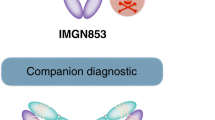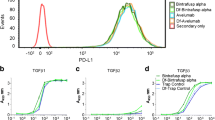Abstract
The monoclonal antibody (mAb) MOv18 binds the membrane alpha isoform of the folate receptor (FR) which is overexpressed in human ovarian carcinoma cells. Exploiting the targeting capacity of this mAb, we developed and preclinically validated a protocol for the stable labeling of the mAb with 90Y, an isotope which has shown promise in cancer radioimmunotherapy. MOv18 was derivatized with the stable macrocyclic ligand p-isothiocyanatobenzyl-1,4,7,10-tetraazacyclododecane-1,4,7,10- tetraacetic acid (Bz-DOTA). MOv18-Bz-DOTA conjugates were labeled with 90Y or 111In under metal-free and good laboratory practice conditions. At the optimal Bz-DOTA/mAb derivatization ratio of 4–5, conjugates maintained binding activity up to 6 months, were efficiently labeled with 90Y or 111In (mean labeling yield 85 and 64%, associated to a final mean specific activity of 74 and 37 MBq/mg) and displayed a mean immunoreactivity of 60 and 58%, respectively. The radiolabeled preparations were stable in human serum, with >97% radioactivity associated to mAb at 48 h after labeling. The ability of 90Y- and 111In-MOv18 to localize FR on tumors in vivo was analyzed in nude mice bearing tumors induced by isogenic cell lines differing only in the presence or absence of the relevant antigen [A431FR (FR-positive) and A431tMock (FR-negative)]. In vivo biodistribution in organs other than tumor was comparable in non-tumor-, A431tMock- and A431FR-bearing mice, whereas the median tumor uptake of the radiolabeled reagents, expressed as area under the curve (AUC) and maximum uptake (Umax), was significantly higher (sixfold to sevenfold) in A431FR than in A431tMock tumors (P=0.0465 and P=0.0332, respectively). Mean maximum uptake (% ID/g) for 90Y-MOv18 was 53.7 and 7.4 in A431FR and A431tMock respectively; corresponding values for 111In-Mov18 were 45.0 and 11.3. These data demonstrate the feasibility of 90Y-labeling of MOv18 without compromising antibody binding ability and the immunoreagent-specific localization in vivo on FR-expressing tumors, suggesting the suitability of 90Y-MOv18 for clinical studies.




Similar content being viewed by others
Abbreviations
- mAb:
-
Monoclonal antibody
- FR:
-
Alpha isoform of the folate receptor
- Bz-DOTA:
-
p-isothiocyanatobenzyl-1,4,7,10-tetraazacyclododecane-1,4,7,10-tetraacetic acid
- GLP:
-
Good laboratory practice
- % ID/g:
-
Percent injected dose/g
- AUC:
-
Area under the curve
- Umax:
-
Maximum uptake
- HSA:
-
Human serum albumin
- SDS-PAGE:
-
Sodium dodecyl sulfate polyacrylamide gel electrophoresis
- MALDI-TOF-MS:
-
Matrix-assisted laser desorption/ionization time-of-flight mass spectrometry
- L/P:
-
Ligand/protein ratio
- FITC:
-
Fluorescein-isothiocyanate
- DTPA:
-
Diethylenetriaminepentaacetic acid
- EDTA:
-
Ethylenediaminetetraacetic acid
- ITLC:
-
Instant thin layer chromatography
References
Alvarez RD, Huh WK, Khazaeli MB, Meredith RF, Partridge EE, Kilgore LC, Grizzle WE, Shen S, Austin JM, Barnes MN, Carey D, Schlom J, LoBuglio AF (2002) A phase I study of combined modality (90)Yttrium-CC49 intraperitoneal radioimmunotherapy for ovarian cancer. Clin Cancer Res 8:2806–2811
Andersson H, Elgqvist J, Horvath G, Hultborn R, Jacobsson L, Jensen H, Karlsson B, Lindegren S, Palm S (2003) Astatine-211-labeled antibodies for treatment of disseminated ovarian cancer: an overview of results in an ovarian tumor model. Clin Cancer Res 9:3914S–3921S
Bischof Delaloye A (2003) The role of nuclear medicine in the treatment of non-Hodgkin’s lymphoma (NHL). Leuk Lymphoma 44(Suppl 4):S29–S36
Bottero F, Tomassetti A, Canevari S, Miotti S, Ménard S, Colnaghi MI (1993) Gene transfection and expression of the ovarian carcinoma marker folate binding protein on NIH/3T3 cells increases cell growth in vitro and in vivo. Cancer Res 53:5791–5796
Casalini P, Luison E, Menard S, Colnaghi MI, Paganelli G, Canevari S (1997) Tumor pretargeting: role of avidin/streptavidin on monoclonal antibody internalization. J Nucl Med 38:1378–1381
Chakrabarti MC, Le N, Paik CH, De Graff WG, Carrasquillo JA (1996) Prevention of radiolysis of monoclonal antibody during labeling. J Nucl Med 37:1384–1388
Chappell LL, Ma D, Milenic DE, Garmestani K, Venditto V, Beitzel MP, Brechbiel MW (2003) Synthesis and evaluation of novel bifunctional chelating agents based on 1,4,7,10-tetraazacyclododecane-N,N′,N′′,N′′′-tetraacetic acid for radiolabeling proteins. Nucl Med Biol 30:581–595
Chinn P, Braslawsky G, White C, Hanna N (2003) Antibody therapy of non-Hodgkin’s B-cell lymphoma. Cancer Immunol Immunother 52:257–280
Coney LR, Tomassetti A, Carayannopoulos L, Frasca V, Kamen BA, Colnaghi MI, Zurawski VR Jr (1991) Cloning of a tumor-associated antigen: MOv18 and MOv19 antibodies recognize a folate-binding protein. Cancer Res 51:6125–6132
Crippa F, Buraggi GL, Di Re E, Gasparini M, Seregni E, Canevari S, Gadina M, Presti M, Marini A, Seccamani E (1991) Radioimmunoscintigraphy of ovarian cancer with the MOv18 monoclonal antibody. Eur J Cancer 27:724–729
Crippa F, Bolis G, Seregni E, Gavoni N, Bombardieri E, Scarfone G, Ferrari C, Buraggi GL (1995) Single dose intraperitoneal radioimmunotherapy with the murine monoclonal antibody 131I-MOv18: clinical results in patients with minimal residual disease of ovarian cancer. Eur J Cancer 31A:686–690
Dadachova E, Chappell LL, Brechbiel MW (1999) Spectrophotometric method for determination of bifunctional macrocyclic ligands in macrocyclic ligand-protein conjugates. Nucl Med Biol 26:977–982
DeNardo GL, Bradt BM, Mirick GR, DeNardo SJ (2003) Human antiglobulin response to foreign antibodies: therapeutic benefit? Cancer Immunol Immunother 52:309–316
DeNardo GL, DeNardo SJ, Peterson JJ, Miers LA, Lam KS, Hartmann-Siantar C, Lamborn KR (2003) Preclinical evaluation of cathepsin-degradable peptide linkers for radioimmunoconjugates. Clin Cancer Res 9:3865S-3872S
Dixon KH, Mulligan T, Chung KN, Elwood PC, Cowan KH (1992) Effects of folate receptor expression following stable transfection into wild type and methotrexate transport-deficient ZR-75–1 human breast cancer cells. J Biol Chem 267:24140–24147
Epenetos AA, Hird V, Lambert H, Mason P, Coulter C (2000) Long term survival of patients with advanced ovarian cancer treated with intraperitoneal radioimmunotherapy. Int J Gynecol Cancer 10:44–46
Figini M, Ferri R, Mezzanzanica D, Bagnoli M, Luison E, Miotti S, Canevari S (2003) Reversion of transformed phenotype in ovarian cancer cells by intracellular expression of anti folate receptor antibodies. Gene Ther 10:1018–1025
Fogh J, Bean MA, Bruggen J (1978) Comparison of a human tumor cell line before and after growth in the nude mouse. In: Fogh J, Giovanella B (eds) The nude mouse in experimental and clinical research. Academic, New York, pp 215–234
Gadina M, Canevari S, Ripamonti M, Mariani M, Colnaghi MI (1991) Preclinical pharmacokinetics and localization studies of the radioiodinated anti-ovarian carcinoma MAb MOv18. Nucl Med Biol 18:403–408
Griffiths GL (1995) Cancer therapy with radiolabelled antibodies. In: Goldenberg DM (ed) Radiochemistry of therapeutic radionuclides. CRC Press, Boca Raton, Florida, p 47
Hnatowich DJ, Childs RL, Lanteigne D, Najafi A (1983) The preparation of DTPA-coupled antibodies radiolabeled with metallic radionuclides: an improved method. J Immunol Methods 65:147–157
Jemal A, Tiwari RC, Murray T, Ghafoor A, Samuels A, Ward E, Feuer EJ, Thun MJ (2004) Cancer statistics. CA Cancer J Clin 54:8–29
Kukis DL, DeNardo SJ, DeNardo GL, O’Donnell RT, Meares CF (1998) Optimized conditions for chelation of yttrium-90-DOTA immunoconjugates. J Nucl Med 39:2105–2110
Lewis MR, Raubitschek A, Shively JE (1994) A facile, water-soluble method for modification of proteins with DOTA. Use of elevated temperature and optimized pH to achieve high specific activity and high chelate stability in radiolabeled immunoconjugates. Bioconjug Chem 5:565–576
Lindmo T, Boven E, Cuttitta F, Fedorko J, Bunn PA Jr (1984) Determination of the immunoreactive fraction of radiolabeled monoclonal antibodies by linear extrapolation to binding at infinite antigen excess. J Immunol Methods 72:77–89
McMurry TJ, Brechbiel M, Kumar K, Gansow OA (1992) Convenient synthesis of bifunctional tetraaza macrocycles. Bioconjug Chem 3:108–117
Meares CF, McCall MJ, Reardan DT, Goodwin DA, Diamanti CI, McTigue M (1984) Conjugation of antibodies with bifunctional chelating agents: isothiocyanate and bromoacetamide reagents, methods of analysis, and subsequent addition of metal ions. Anal Biochem 142:68–78
Miotti S, Canevari S, Ménard S, Mezzanzanica D, Porro G, Pupa SM, Regazzoni M, Tagliabue E, Colnaghi MI (1987) Characterization of human ovarian carcinoma-associated antigens defined by novel monoclonal antibodies with tumor-restricted specificity. Int J Cancer 39:297–303
Miotti S, Negri DRM, Valota O, Calabrese M, Bolhuis RLH, Gratama JW, Colnaghi MI, Canevari S (1999) Level of anti-mouse antibody response induced by bispecific monoclonal antibody OC/TR in ovarian carcinoma patients is associated with longer survival. Int J Cancer 84:62–68
Miotti S, Bagnoli M, Tomassetti A, Colnaghi MI, Canevari S (2000) Interaction of folate receptor with signaling molecules lyn and Gα13 in detergent-resistant complexes from the ovary carcinoma cell line IGROV1. J Cell Sci 113:349–357
Moi MK, DeNardo SJ, Meares CF (1990) Stable bifunctional chelates of metals used in radiotherapy. Cancer Res 50:789s–793s
Ozols RF, Bookman MA, Connolly DC, Daly MB, Godwin AK, Schilder RJ, Xu X, Hamilton TC (2004) Focus on epithelial ovarian cancer. Cancer Cell 5:19–24
Paganelli G, Belloni C, Magnani P, Zito F, Pasini A, Sassi I, Meroni M, Mariani M, Vignali M, Siccardi AG, Fazio F (1992) Two-step tumor targetting in ovarian cancer patients using biotinylated monoclonal antibodies and radioactive streptavidin. Eur J Nucl Med 19:322–329
Peterson JJ, Pak RH, Meares CF (1999) Total solid-phase synthesis of 1,4,7,10-tetraazacyclododecane-N,N′,N′′,N′′′-tetraaceticacid- functionalized peptides for radioimmuno-therapy. Bioconjug Chem 10:316–320
Srivastava SC (1996) Criteria for the selection of radionuclides for targeting nuclear antigens for cancer radioimmunotherapy. Cancer Biother Radiopharm 11:43–50
Stimmel JB, Stockstill ME, Kull FC Jr (1995) Yttrium-90 chelation properties of tetraazatetraacetic acid macrocycles, diethylenetriaminepentaacetic acid analogues, and a novel terpyridine acyclic chelator. Bioconjug Chem 6:219–225
Toffoli G, Cernigoi C, Russo A, Gallo A, Bagnoli M, Boiocchi M (1997) Overexpression of folate binding protein in ovarian cancers. Int J Cancer 74:193–198
United Kingdom Co-ordinating Committee on Cancer Research (UKCCCR) (1998) Guidelines for the welfare of animals in experimental neoplasia, 2nd edn. Br J Cancer 77:1–10
van Zanten-Przybysz I, Molthoff CF, Roos JC, Plaizier MA, Visser GW, Pijpers R, Kenemans P, Verheijen RH (2000) Radioimmunotherapy with intravenously administered 131I-labeled chimeric monoclonal antibody MOv18 in patients with ovarian cancer. J Nucl Med 41:1168–1176
van Zanten-Przybysz I, Molthoff CF, Roos JC, Verheijen RH, van Hof A, Buist MR, Prinssen HM, den Hollander W, Kenemans P (2001) Influence of the route of administration on targeting of ovarian cancer with the chimeric monoclonal antibody MOv18: i.v. vs. i.p. Int J Cancer 92:106–114
Acknowledgements
The authors thank Gloria Bosco for manuscript preparation. This work was partially supported by AIRC-FIRC and a MIUR grant to Dompé.
Author information
Authors and Affiliations
Corresponding author
Additional information
Angela Coliva and Alberto Zacchetti contributed equally to this work.
Rights and permissions
About this article
Cite this article
Coliva, A., Zacchetti, A., Luison, E. et al. 90Y Labeling of monoclonal antibody MOv18 and preclinical validation for radioimmunotherapy of human ovarian carcinomas. Cancer Immunol Immunother 54, 1200–1213 (2005). https://doi.org/10.1007/s00262-005-0693-2
Received:
Accepted:
Published:
Issue Date:
DOI: https://doi.org/10.1007/s00262-005-0693-2




